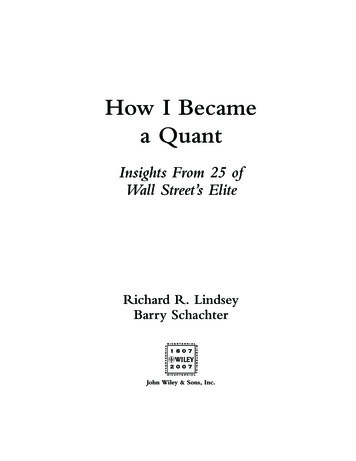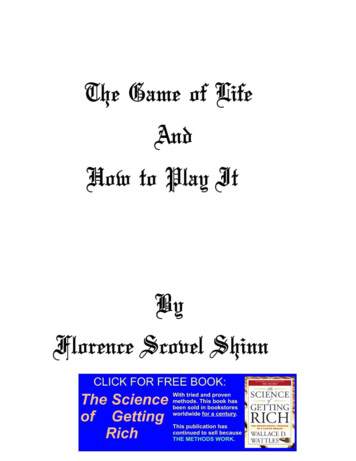
Transcription
P1: OTE/PGNJWPR007-LindseyP2: OTEMay 28, 200715:16How I Becamea QuantInsights From 25 ofWall Street’s EliteRichard R. LindseyBarry SchachterJohn Wiley & Sons, Inc.i
P1: OTE/PGNJWPR007-LindseyP2: OTEMay 28, 200715:16iv
P1: OTE/PGNJWPR007-LindseyP2: OTEMay 28, 200715:16How I Becamea QuantInsights From 25 ofWall Street’s EliteRichard R. LindseyBarry SchachterJohn Wiley & Sons, Inc.i
P1: OTE/PGNJWPR007-LindseyP2: OTEMay 28, 200715:16C 2007 by Richard R. Lindsey and Barry Schachter. All rights reserved.Copyright Published by John Wiley & Sons, Inc., Hoboken, New Jersey.Published simultaneously in Canada.Wiley Bicentennial Logo: Richard J. PacificoNo part of this publication may be reproduced, stored in a retrieval system, or transmittedin any form or by any means, electronic, mechanical, photocopying, recording, scanning,or otherwise, except as permitted under Section 107 or 108 of the 1976 United StatesCopyright Act, without either the prior written permission of the Publisher, orauthorization through payment of the appropriate per-copy fee to the CopyrightClearance Center, Inc., 222 Rosewood Drive, Danvers, MA 01923, (978)-750-8400, fax(978)-646-8600, or on the web at www.copyright.com. Requests to the Publisher forpermission should be addressed to the Permissions Department, John Wiley & Sons, Inc.,111 River Street, Hoboken, NJ 07030, (201)-748-6011, fax (201)-748-6008, or online atwww.wiley.com/go/permissions.Limit of Liability/Disclaimer of Warranty: While the publisher and the author have usedtheir best efforts in preparing this book, they make no representations or warranties withrespect to the accuracy or completeness of the contents of this book and specificallydisclaim any implied warranties of merchantability or fitness for a particular purpose. Nowarranty may be created or extended by sales representatives or written sales materials.The advice and strategies contained herein may not be suitable for your situation.Youshould consult with a professional where appropriate. Neither the publisher nor authorshall be liable for any loss of profit or any other commercial damages, including but notlimited to special, incidental, consequential, or other damages.For general information on our other products and services or for technical support, pleasecontact our Customer Care Department within the United States at (800)-762-2974,outside the United States at (317)-572-3993 or fax (317)-572-4002.Wiley also publishes its books in a variety of electronic formats. Some content that appearsin print may not be available in electronic formats. For more information about Wileyproducts, visit our Web site at www.wiley.com.Library of Congress Cataloging-in-Publication DataHow I became a quant : insights from 25 of Wall Street’s elite / [compiled and edited by]Richard R. Lindsey, Barry Schachter.p. cm.Includes index.ISBN 978-0-470-05062-0 (cloth)1. Quantitative analysts–United States–Biography. 2. Wall Street (New York, N.Y.)–Biography. 3. Finance–Mathematical models. 4. Finance–Computer programs.5. Financial engineering. I. Lindsey, Richard R., 1954- II. Schachter, Barry.III. Title: Wall Street’s elite.HG172.A2H69 2007322.63 2042–dc222007002383Printed in the United States of America.10 9 8 7 6 5 4 3 2 1ii
P1: OTE/PGNP2: OTEJWPR007-LindseyMay 28, 200715:16Rich would like to dedicate this book to his daughter Nancy, age 4,in the hope that she can find a partial answer contained herein whenshe starts to wonder what he did when she was growing up. In thesame spirit, Barry would like to dedicate this book to his daughterDevra, age 18, who for many years has been asking, “What do youdo at work, Daddy?”, in the conviction that she will find in itscontents a more satisfying answer than she has invariably receivedpreviously, specifically, “I worry about stuff.”iii
P1: OTE/PGNJWPR007-LindseyP2: OTEMay 28, 200715:16iv
P1: OTE/PGNP2: OTEJWPR007-LindseyMay 28, apter 11David LeinweberPresident, Leinweber & Co.A Series of AccidentsGrey Silver ShadowDestroy before ReadingA Little Artificial Intelligence Goes a Long WayHow Do You Keep the Rats from Eatingthe WiresStocks Are Stories, Bonds Are MathematicsHAL’s BrokerChapter 2910131618202326Ronald N. KahnGlobal Head of Advanced Equity Strategies, BarclaysGlobal Investors29Physics to FinanceBARRA’s First Rocket Scientist3034v
P1: OTE/PGNJWPR007-LindseyP2: OTEMay 28, 2007viChapter 3Chapter 4Chapter 515:16CONTENTSActive Portfolio ManagementBarclays Global InvestorsThe Future424446Gregg E. BermanStrategic Business Development, RiskMetrics Group49A Quantitative BeginningPutting It to the TestA Martian SummerPhysics on TrialA Twist of FateA Point of InflectionA Circuitous Route to Wall StreetThe Last Mile5053575759606165Evan SchulmanChairman, Upstream Technologies, LLC67MeasurementMarket CyclesProcessRiskAnd ReturnTrading CostsInformationless TradesApplying it AllElectronic TradingLattice TradingNet Leslie RahlPresident, Capital Market Risk Advisors83Growing Up in ManhattanCollege and Graduate SchoolNineteen Years at CitibankFifteen Years (So Far!) Running Capital MarketRisk Advisors83858890
P1: OTE/PGNP2: OTEJWPR007-LindseyMay 28, 200715:16ContentsChapter 6Going PluralThe Personal SideSo How Did I Become a Quant?929292Thomas C. WilsonChief Insurance Risk Officer, ING Group95Quantitative Finance: The Means to an End?The QuestionsThe Early 1990s: The Market Risk EraThe Late 1990s: The Credit Risk EraThe Great Strategy Debate: From the 1990sto TodayLessons LearnedChapter 7Neil ChrissFormer Managing Director of Quantitative Strategies,SAC Capital Management, LLCThe Glass Bead GameOf Explorers and Mountain ClimbersComputersCollege YearsThe University of Chicago PhD ProgramAcademiaThe Harvard Mathematics DepartmentMoving to Wall StreetQuant ResearchQuant Research and the Mathematics ofPortfolio TradingQuantitative Portfolio ManagementMathematical Finance EducationFinal ThoughtsChapter 8viiPeter CarrHead of Quantitative Financial Research, BloombergMy First Eureka MomentAccounting for the Future Insteadof the 28130131133137138139
P1: OTE/PGNJWPR007-LindseyP2: OTEMay 28, 200715:16viiiChapter 9CONTENTSPostdoctoral StudiesAnd in the End . . .140141Mark AnsonCEO, Hermes Pensions Management Ltd. CEO,British Telecommunications Pension Scheme143PhD, Why Not?Legal ArbitrageManaging the OutcomeCertain Uncertainty144146148149Chapter 10 Bjorn FlesakerSenior Quant, Bloomberg L.P.Growing UpChoosing AcademicsHeeding the Call of the StreetBecoming a Real Quant AgainChapter 11 Peter JäckelThe English ConnectionLondon CallingCutting One’s TeethAll the Models in the WorldFor Future ReferenceTo the FrontChapter 12 Andrew DavidsonPresident, Andrew Davidson & Co., Inc.Conjecture 1: If It Quacks Like a Quant . . .Lemma 1: If You Don’t Know Where You AreGoing, Any Road Will Get You ThereLemma 2: Pay No Attention to the Man behindthe 79181
P1: OTE/PGNP2: OTEJWPR007-LindseyMay 28, 200715:16ContentsTheorem 1: If It May Be True in Theory but ItWon’t Work in Practice, Get a Better TheoryTheorem 2: To Thine Own Self Be TrueChapter 13 Andrew B. WeismanManaging Director, Merrill LynchEconometric VoodooTrading for Fun and ProfitTools of the TradeLessons LearnedChapter 14 Clifford S. AsnessManaging and Founding Principal, AQR CapitalManagement, LLCChicagoA Big DecisionOn Our OwnMoonlightingGeeks of the World UniteChapter 15 Stephen KealhoferManaging Partner, Diversified Credit InvestmentsA StartupPractical DefaultsThe EntrepreneurInventing a BusinessPortfolio Management of Credit RiskA Room with a ViewChapter 16 Julian ShawHead Risk Management & Quantitative Research,Permal GroupGordon CapitalCIBCBarclays 1213214217219220223227229231232
P1: OTE/PGNJWPR007-LindseyxP2: OTEMay 28, 200715:16CONTENTSFat Tails and Thin PeaksAdventures in CDO LandThe Strange Evolution of Value at RiskA ParadoxPermalWhat Makes a Good Quant?The Art of Leaving Things OutThe Art of Choosing the Right ToolsDo Quants Lack Business Sense?TipsChapter 17 Steve AllenDeputy Director, Masters Program in Mathematics inFinance, Courant Institute of Mathematical Sciences,New York UniversityIn Which the Author Is Seriously MisledIn Which a Fortuitous Opportunity AppearsIn Which Reason Prevails and All RejoiceChapter 18 Mark KritzmanPresident and CEO, Windham CapitalManagement, LLC233234235236236237238238240241243243246248251A Brief ChronologyHow I Developed My Quant SkillsHow I Applied My Quantitative TrainingThe Future for Quants252254255261Chapter 19 Bruce I. Jacobs and Kenneth N. LevyPrincipals, Jacobs Levy Equity Management263Portraits of Two InvestorsNew Concepts, Foggy IdeasThe Jacobs Levy Investment ApproachBenefits of DisentanglingIntegrating the Investment ProcessRelaxing Portfolio Constraints264265268269273275
P1: OTE/PGNP2: OTEJWPR007-LindseyMay 28, 200715:16ContentsIntegrated Long-Short OptimizationBooks and an Ethical DebatePortfolio Optimization and Market Simulationwith ShortingChapter 20 Tanya Styblo BederChairman, SBCCYaleFirst BostonGraduate SchoolSwapsGiving BackChapter 21 Allan MalzHead of Risk Management, Clinton GroupHow Not to Get a PhDHow Not to Get a PhD, ContinuedRiskMetrics’ Salad DaysNo More Mr. Nice GuyChapter 22 Peter MullerSenior Advisor, Morgan StanleyWhat’s that Smell?Life at BARRAYou Gotta Know When to Fold ’emThe Call that Changed EverythingChapter 23 Andrew J. StergePresident, AJ Sterge (a division of MagnetarFinancial, LLC)On to the Real WorldCooper NeffEarly Days at Cooper NeffActive Portfolio StrategiesHow I Became a 05305308310312317320321322324327
P1: OTE/PGNP2: OTEJWPR007-LindseyMay 28, 200715:16xiiCONTENTSChapter 24 John F. (Jack) MarshallSenior Principal of Marshall, Tucker & Associates,LLC and Vice Chairman of the InternationalSecurities ExchangeFrom Premed to DerivativesFrustration with Academia and the Birth ofa ProfessionThe IAFE and the Road to MSFE Degrees329330331334Notes339Bibliography359About the Contributors363About the Authors379Index381
P1: OTE/PGNP2: OTEJWPR007-LindseyMay 28, 200715:16AcknowledgmentsWe would like to acknowledge our editors, Bill Falloon andEmilie Herman of Wiley, for their efforts and support; SaraPick and Paige Lesniak for administrative support throughout the process; and Rebecca Lindsey (who is not a quant!) for her careful reading and editing of this work. Barry would like to thank KarenHoogsteen, for her always-ready support, encouragement, and patience.Finally, we want to thank each of the contributors for taking time outof their busy lives to share their experiences.xiii
P1: OTE/PGNJWPR007-LindseyP2: OTEMay 28, 200715:16xiv
JWPR007-LindseyMay 7, 200718:27IntroductionBecause you are reading this introduction, one of four things mustbe true. You are a quant and are intrigued by the idea of readingthe stories of others like you. You are not a quant, but aspireto quantness, and you are seeking some insight on how to achieve thatgoal. You are neither a quant, nor have such aspirations, but you wantto understand the way Wall Street really works, perhaps to gain someperspective on the vast and unsympathetic forces affecting your life inmysterious ways. Or, misshelved among the science fiction and fantasytitles by a harried employee, the title has struck your fancy as, perhaps,a potentially satisfying space opera. There might be other things besidesthese four, but we can’t think of any. For all of you except the fourthgroup, we are pretty sure this book will provide considerable satisfaction.(For the fourth group, who knows?) By way of introduction, we willexplain from our perspective the roots, roles, and contributions of theWall Street quant.We begin by defining the Quant. Mark Joshi, a famous quant, hasproposed this definition:A quant designs and implements mathematical models for thepricing of derivatives, assessment of risk, or predicting marketmovements.11
JWPR007-Lindsey2May 7, 200718:27h ow i b e cam e a quantPerhaps some of the terms used in this definition require definitionthemselves. A mathematical model is a formula, equation, group of equations, or computational algorithm that attempts to explain some typeof relationship. For example, Einstein’s famous e mc 2 is a model thatdescribes the relationship between energy and mass.Quants implement models that focus on financial relationships. Perhaps the most famous of these is the Black-Scholes option pricing formula, which describes the relationship between the prices of two financial instruments that have a particular connection. The development ofthe Black-Scholes model (between 1969 and 1973) is often cited as oneof the factors that started the quant revolution on Wall Street, but thatis an oversimplification.Returning to the definition of a quant, the derivatives for whichquants design models are financial instruments whose values depend on(or are determined by) the future value of some quantity. This definitionmay seem vague—and it is. Derivatives exist in such variety that anydefinition hoping to be all-encompassing has to be vague.One concrete and ubiquitous example of a derivative is an equitycall option (a call). Someone who buys a call has purchased the futureright to buy the specified company’s common shares, not at the marketprice, but at the price stated in the option contract.Options have been around for a long time, but one date is commonlycited as the trigger for the derivatives revolution (which is inextricablyassociated with the quant revolution). That date is April 26, 1973, thoughto call this the beginning of the derivatives revolution is an oversimplification. On this date there was an earthquake off the coast of Hawaii,but the real earthquake that day was in Chicago. The Chicago BoardOptions Exchange (CBOE) became the first organized exchange to haveregular trading in equity options. A humble beginning, certainly, as only911 option contracts were traded on 16 different equities. Now, eachyear, hundreds of millions of equity option contracts on thousands ofcompanies trade on dozens of exchanges (both physical and electronic)around the world.The key ingredient that ties quants to derivatives and the other twofunctions identified by Joshi (risk assessment and predicting markets) ismathematical know-how. The Black-Scholes option pricing formula isa good example of this.
JWPR007-LindseyMay 7, 200718:27Introduction3The model, as it was first presented, was obtained by employing a result from physics, the solution to a particular partial differential equationcalled the heat-transfer equation. The level of abstractness involved in thiswork frequently inspires awe, fear, and even derision among nonquants.Consider this quotation from Time magazine of April 1994, cited byPeter Bernstein: “Prices of derivatives are not based on old-fashionedhuman hunches but on calculations designed and monitored by computer wizards using abstruse mathematical formulas . . . developed byso-called quants . . . ”2Wizards, indeed. Even Emanuel Derman, one of the most famous ofquants, feels compelled to assert that “[t]he Black-Scholes model tells us,almost miraculously, how to manufacture an option . . . ”3 (italics added).As the knowledge necessary to perform such feats is not a part ofthe regular secondary-school math curriculum, facility with derivativesrequires a level of quantitative (hence “quant”) training and skill confinedto the mathematical specialist.Where can these specialists be found? For Wall Street, the breedinggrounds of future quants are the halls of academe, and more specifically,graduate departments of physics, mathematics, engineering, and (to alesser extent) finance and economics. The favored candidates are holders of the degree of PhD, but not exclusively so. More recently, a newbreeding ground of quants has arisen in schools that have begun teaching more focused curricula, leading to master’s in quantitative finance,master’s in financial engineering, master’s in computational finance, andmaster’s in mathematical finance, for example.Okay—the reader will now be asking, “So that’s what quants do andwhere they come from, but why do they do it?” The obvious answer, asyou readers of the second group have already figured out, is that being aquant is financially rewarding. It is financially rewarding because a quantproduces something with significant utility in the financial marketplace.Still, such an answer would have been greeted with derision by thefamous mathematician G. H. Hardy. In his apologia to mathematicsresearch he states,The “real” mathematics of the ‘real’ mathematicians, themathematics of Fermat and Euler and Gauss and Abel andRiemann, is almost wholly “useless” . . . It is not possible to
JWPR007-Lindsey4May 7, 200718:27h ow i b e cam e a quantjustify the life of any genuine professional mathematician onthe ground of the ‘utility’ of his work.4But before we weep for quants who, while well-rewarded financially,have failed to justify their lives when measured by Hardy’s yardstick, itmust be noted that the yardstick has a crack in it. The work of twoof Hardy’s icons, Pierre Fermat and Frederick Gauss, perhaps above allother mathematicians, have contributed to the utility of quants’ efforts.In truth, Hardy’s view is really a throwback to the Middle Ages,when the idea of science was governed by the Aristotelian concept ofknowledge as tautology. In other words, all things that we can say we knowto be true can be proven true by mathematical logic alone. Utility is nota consideration. In contrast, the Enlightenment view of science (theview of Francis Bacon and his intellectual followers) defines science interms of improving the understanding of the forces at work in the worldwith which we interact. In this context, utility is a natural measure ofscientific contribution.Fermat, in the seventeenth century, was the first to correctly solvecertain problems related to games of chance, problems posed to him (andto Blaise Pascal, a mathematician famous for his triangle, among otherthings) by a well-known player of such games, the Chevalier de Mere,who was looking, not for Aristotelian truth, but for the proper rules touse to split the pot of cash wagered in a game that ends before there is awinner. If Fermat wasn’t a quant by Joshi’s definition, then we can’t tella quant from a quail. As Douglas Adams (author of the science fictionclassic, The Hitchhiker’s Guide to the Galaxy) said, “If it looks like a duck,and quacks like a duck, we have at least to consider the possibility thatwe have a small aquatic bird of the family anatidae on our hands.”It is worth noting that Fermat’s work was not the first to addresspot-splitting; methods of splitting the pot in unfinished games of chancepredated Fermat’s solution. However, his innovation replaced the earlierad hoc, incorrect practice, with a new, fair distribution method.Such is the nature of many of the contributions or innovations madeby quants. Options as distinct financial instruments have been traded forhundreds of years. For example, options on agricultural commoditieswere traded regularly during the American Civil War. Early twentiethcentury financial market participants in Chicago and New York actively
JWPR007-LindseyMay 7, 200718:27Introduction5traded commodity and equity options during regular time periods, albeitoff the exchange floors, and prices were reported in the papers. LikeFermat, what Fischer Black and Myron Scholes (and Robert Merton)added, was a way to determine the “fair” value of an option (subject tovarious caveats related to the reasonableness of the model’s assumptions).Once adopted, their solution replaced the prior ad hoc pricing approach.Fermat is not the only historical example of a scientist devising afinancial innovation that today would label him as a quant. A particularlystriking example is the role quants played in improving governmentfinance practices as far back as the sixteenth century. A common meansof financing municipal and state debt in the Renaissance was the issuanceof life annuities. In return for providing a sum to the government, theprovider could designate that a regular annual payment go to a designeefor life. The annuity was the return over time of both the amount lentand interest on the loan.Originally, governments, in setting the amount of the annuity to bepaid, did not take into account the age of payee. In some cases, the lifeannuity payments already equaled the initial sum provided in exchangewithin six years. Quite a boon for a very young and healthy designee!In 1671, the mathematician Johan de Witt developed a model based onthe work of an even more famous mathematician, Christian Huygens, tocompute an annuity payment that fairly reflected the expected remaininglife of the payee.So the quant revolution didn’t start in 1973. Nor can it be exclusively attributed to the development of the Black-Scholes model. Butsomething caused a “quantum” change in the significance of roles playedby quants. What was it? Conventional wisdom identifies several, almostcontemporaneous, factors. The beginning of trading in exchange-listedequity options, and the publication of the Black-Scholes option pricing model result, both in 1973, have already been noted. Also citedby pundits is the explosive advance in computing power, including thearrival of desktop computing around 1980. Technological developmentsmade practical the analysis of many previously daunting mathematicalproblems. Numerical methods for solving problems are rarely considered elegant or beautiful by academics, for whom these are importantcriteria in judging a model’s value. For quants, however, the result iswhat matters.
JWPR007-Lindsey6May 7, 200718:27h ow i b e cam e a quantThe last factor commonly included in this list is the dramatic increasein the volatility of prices, or to put it differently, an increase in uncertaintyabout the future value of assets. This increase in uncertainty resultedfrom several factors, including the abandonment of fixed exchange ratesin 1973, the elimination of Vietnam War era price controls in 1974, theOil Embargo of 1973, the high inflation environment of the immediatepostVietnam War period, the deregulation of international trade in goodsand services, and the relaxation of controls in international capital flows.This increasing volatility or uncertainty was the true catalyst for thequant revolution. To put it more accurately, it was the aversion to increasing uncertainty experienced by financial market participants—actual,live humans—that led to the quant revolution.There may be no consensus among the financial theorists abouthow people perceive uncertainty (or misperceive it, as emphasized byNassim Taleb5 ). There also may be no consensus about how people copewith (i.e., make choices or decisions under) uncertainty. Nevertheless,everyone accepts that people don’t like it.6When faced with an increase in uncertainty, people try to avoid it.That avoidance may manifest itself in various ways. The quant revolutionhas given people the opportunity to avoid unwanted financial risk byliterally trading it away, or more specifically, paying someone else to takeon the unwanted risk.Not long after publication of the Black-Scholes option pricingmodel, academics and practitioners began to view it as providing ablueprint for modifying exposure to risk, rather than simply as a methodfor determining the fair value of an esoteric financial instrument.7When people buy and sell financial instruments, they are tradingrisks. Buying a bond issued by General Motors is taking on a specific setof risks related to potential future bankruptcy and fluctuations in futureinterest rates. The return expected from that transaction is compensationfor the risk taken on. In this sense, all financial instruments can bethought of baskets of risks.When you start thinking this way, it is a small step to begin to lookfor other risks that can be traded, and thus to view in a new light theway all risks are traded, and to think of new financial instruments thatwill allow those risks to be traded, either individually or combined inunique ways.
JWPR007-LindseyMay 7, 200718:27Introduction7In 1997, the Nobel prize committee put it this way, when they honored Scholes and Merton with the Prize in Economic Science (Blackhad died by this date, and the Nobel prize is not awarded posthumously):“Their methodology has . . . generated many new types of financial instruments and facilitated more efficient risk management in society.”8Once this new way of thinking took hold, the possibilities for creating new ways to allow people to modify their exposure to risk or toshare risks among themselves were seen to be almost literally infinite,and so, also, were the potential profits to Wall Street firms obtained fromproviding these new risk-shifting opportunities to market participants.There really was only one missing ingredient.That missing ingredient, the intellectual horsepower to developmathematical models to fulfill the dream of unlimited ability to managerisks through trading financial instruments, brings us full circle. As PerryMehring said,Originally a somewhat motley bunch of ex-physicists, mathematicians, and computer scientists, joined by a very few finance academics . . . had been drawn to Wall Street by the demand for quantitative skills to support the increasing technicalsophistication of investment practice at the leading investmenthouses.9The motley bunch, the providers of the horsepower, are the quants.Here are the stories of just a few of them.
JWPR007-LindseyMay 7, 200718:278
JWPR007-LindseyMay 7, 200716:12Chapter 1David LeinweberPresident, Leinweber & Co.Iwish I could tell one of those stories about how, when I was inthe eighth grade, I noticed a pricing anomaly between the out-ofthe-money calls on soybean futures across the Peruvian and Londonmarkets and started a hedge fund in my treehouse and now own Cleveland. But I can’t. In the eighth grade I was just a nerdy kid tryingto keep my boisterous pals from blowing up my room by mixing allthe chemicals together and throwing in a match. In fact, I really can’ttell any true stories about eighth graders starting hedge funds in treehouses buying Cleveland. Make it sophomores in dorm rooms who buychunks of Chicago, Bermuda, or the Cayman Islands, and we have lots ofmaterial.9
JWPR007-Lindsey10May 7, 200716:12h ow i b e cam e a quantA Series of AccidentsMy eventual quantdom was not the culmination of a single-minded,eye-on-the-prize march to fulfill my destiny. It was the result of a seriesof accidents. In college, my interest in finance was approximately zero.I came to MIT in 1970 as a math major, as did many others, because Ididn’t know much about other subjects like physics or computer science.I quickly discovered the best gadgets were outside the math department.And the guys in the math department were a little weird, even by MITstandards. This was back when even a pretty crummy computer costmore than an average house. A good one cost millions, and filled a roomthe size of a basketball court. MIT, the ultimate toy store for geeks,had acquired a substantial inventory of computing machinery, startingas soon as it was invented, or sooner, by inventing it themselves. Theprofessors kept the latest and greatest for themselves and their graduatestudent lackeys, but they were happy to turf last year’s model to theundergrads.Foremost among these slightly obsolete treasures was the PDP-1-X,which is now justly enshrined in the Computer Museum. The PDP-1-Xwas a tricked-out version of the PDP-1, the first product of the DigitalEquipment Corporation (DEC). The story of DEC is an early computerindustry legend now fading in an era where many people believe BillGates invented binary numbers.DEC founder Ken Olsen worked at MIT’s Lincoln Laboratory,where the Air Force was spending furiously to address a central question facing the nation after World War II: “What do we do about theBomb?” Think about the air war in World War I. There were guys inopen cockpits wearing scarves yelling, “Curse you, Red Baron!” By theend of World War II, just 30 years later, they were potential destroyers ofworlds. Avoiding the realization of that potential became a central goalof the United States.If a Soviet bomb was headed our way, it would come from thenorth. A parabolic ballistic trajectory over the pole was how the rocketsof the era could reach us. This begat the Distant Early Warning (DEW)and Ballistic Missile Early Warning (BMEW) lines of radars across thenorthern regions of Alaska and Canada. The DEW and BMEW lines,conceived for military purposes, drove much of the innovation that we
JWPR007-LindseyMay 7, 200716:12David Leinweber11see everywhere today. Lines of radars produce noisy analog signals thatneed to be combined and monitored.Digital/analog converters were first on the DEW line, now in youriPod. Modems, to send the signals from one radar computer to others,were first developed to keep the Cold War cold. Computers themselves,excruciatingly large and unreliable when constructed from tubes, becametransistorized, and less excruciating. This is where Ken Olsen comes in.Working at MIT to develop the first transistorized computers for theDEW line, he and his colleagues built a series of experimental machines,the TX-0 (transistor experiment zero), the TX-1, and the TX-2. Thelast, the TX-2, actually worked well enough to become a mother lode ofinnovation. The first modem was attached to it, as was the first graphicdisplay, and the first computer audio.Olsen, a bright and entrepreneurial sort, realized that he knew moreabout building transistorized computers than anyone else, a
No More Mr. Nice Guy 302. Chapter 22 Peter Muller. Senior Advisor, Morgan Stanley. 305. What’s that Smell? 305 Life at BARRA 308 You Gotta Know When to Fold ’em 310 The Call that Changed Everything 312. Chapter 23 Andrew J. Sterge. President, AJ Sterge (a division of Magnetar Fina




